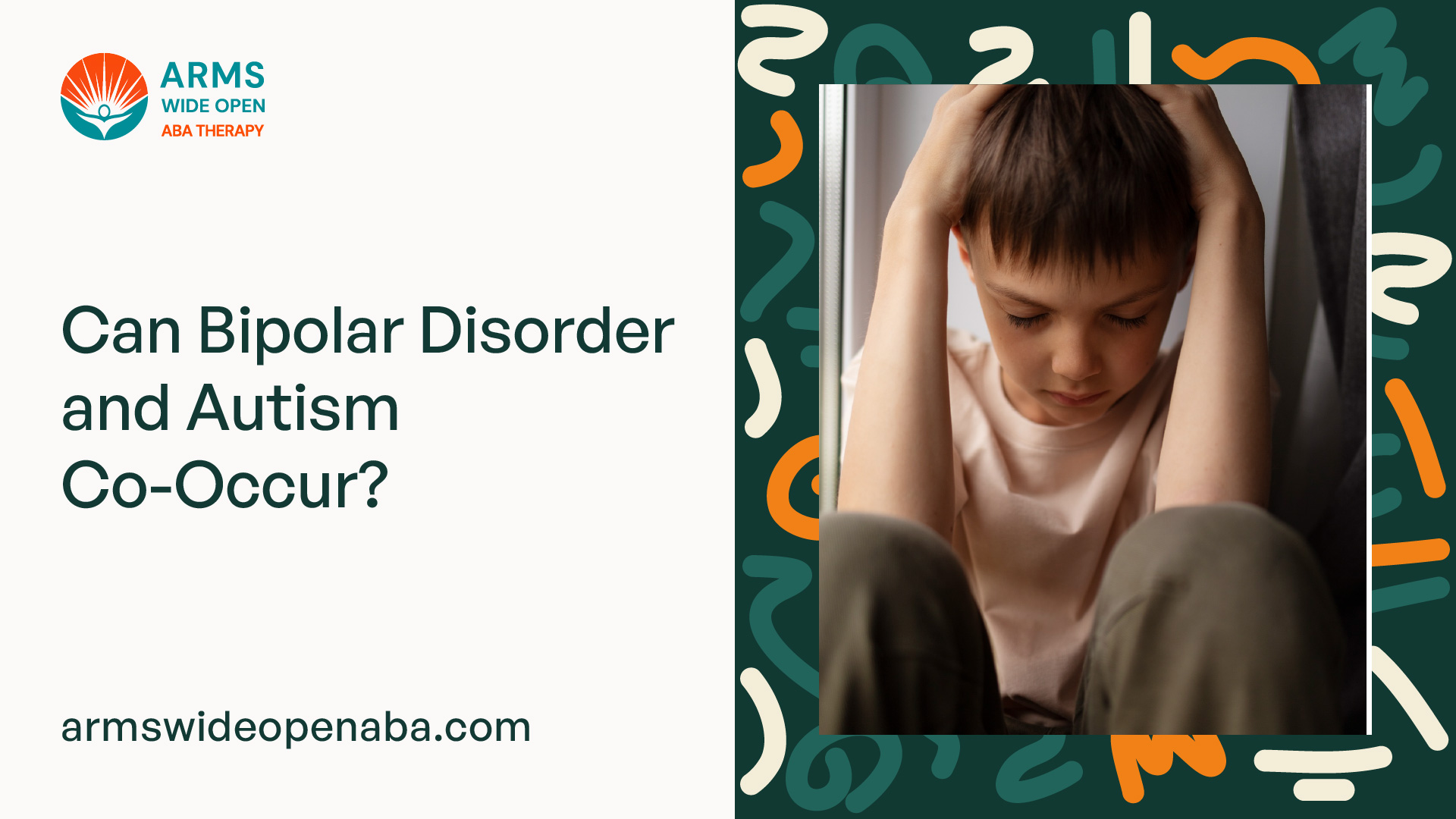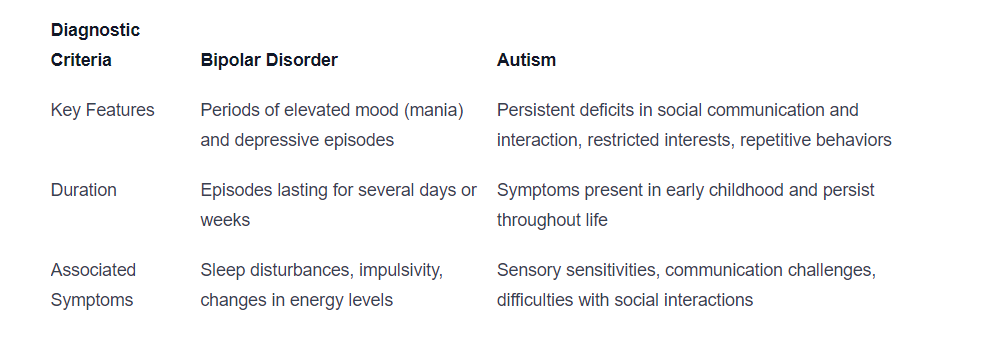Can Bipolar Disorder and Autism Co-Occur?
Unraveling the intricate relationship between bipolar disorder and autism. Can they co-occur? Find out the truth.

Understanding Bipolar Disorder and Autism
To comprehend the potential co-occurrence of bipolar disorder and autism, it is crucial to have an understanding of each condition individually, including their prevalence and characteristics.

What is Bipolar Disorder?
Bipolar disorder, also known as manic-depressive illness, is a mental health disorder characterized by extreme shifts in mood, energy, and activity levels. Individuals with bipolar disorder experience periods of intense mania, marked by elevated mood, increased energy, and impulsive behavior, as well as episodes of depression, characterized by low mood, decreased energy, and feelings of hopelessness.
Bipolar disorder affects people of all ages, including children, adolescents, and adults. The disorder can significantly impact daily functioning and quality of life if left unmanaged. It is important to note that bipolar disorder is distinct from the normal ups and downs that people experience in their lives.
What is Autism?
Autism, or autism spectrum disorder (ASD), is a developmental disorder that affects communication, social interaction, and behavior. Individuals with autism may have difficulties with verbal and nonverbal communication, challenges in forming and maintaining relationships, and exhibit repetitive behaviors or restricted interests.
Autism is a spectrum disorder, meaning it encompasses a wide range of symptoms and levels of impairment. While some individuals with autism may require significant support, others may have higher functioning abilities and excel in specific areas. Autism is typically diagnosed in early childhood, but the severity and presentation of symptoms can vary greatly.
Prevalence and Characteristics
Understanding the prevalence and characteristics of bipolar disorder and autism can provide insights into their co-occurrence.
Bipolar disorder affects approximately 2.8% of the global population, with no significant difference in prevalence between males and females. It often manifests in late adolescence or early adulthood, although it can develop at any age. The disorder is characterized by recurrent episodes of mania and depression, which can vary in duration and intensity.
Autism has a higher prevalence, affecting approximately 1 in 54 children in the United States. It is more prevalent in males, with a ratio of around 4:1 compared to females. Autism is a lifelong condition, and its symptoms typically emerge in early childhood. These symptoms may include challenges in social interaction, communication difficulties, and repetitive or restrictive behaviors.
Understanding the individual characteristics and prevalence rates of bipolar disorder and autism lays the foundation for exploring their potential co-occurrence. The next section will delve into the relationship between these two conditions, including overlapping symptoms and challenges, as well as methods for differentiation.
Exploring the Relationship
When it comes to the relationship between bipolar disorder and autism, there is ongoing research and debate. Let's dive into this complex topic and explore whether these two conditions can co-occur, the overlapping symptoms and challenges they present, and how they can be differentiated.
Can Bipolar Disorder and Autism Co-Occur?
Research suggests that there can be an overlap between bipolar disorder and autism, leading to the co-occurrence of these two conditions in some individuals. While the exact relationship between the two is not yet fully understood, studies have shown that individuals with autism are at a higher risk of developing bipolar disorder compared to the general population.
Overlapping Symptoms and Challenges
Bipolar disorder and autism share some common symptoms, which can make diagnosis and differentiation challenging. Both conditions can involve difficulties with social interactions, emotional regulation, and sensory sensitivities. Additionally, individuals with both conditions may experience challenges in communication and exhibit repetitive behaviors.
The overlapping symptoms can complicate the diagnostic process, as certain characteristics may be attributed to either bipolar disorder or autism. It is essential for healthcare professionals to conduct a thorough evaluation to accurately identify and differentiate between the two conditions.
Differentiating between Bipolar Disorder and Autism
While there can be overlapping symptoms, there are also distinct features that can help differentiate bipolar disorder from autism. Bipolar disorder is characterized by episodes of extreme mood swings, ranging from manic episodes (elevated mood, increased energy) to depressive episodes (low mood, decreased energy). On the other hand, autism is primarily characterized by difficulties in social communication and interaction, as well as restricted and repetitive patterns of behavior.
To differentiate between bipolar disorder and autism, it is crucial to assess the individual's history, symptoms, and patterns of behavior. A comprehensive evaluation by a qualified healthcare professional, such as a psychiatrist or psychologist, is necessary to make an accurate diagnosis.
Understanding the relationship between bipolar disorder and autism, along with the challenges of overlapping symptoms, is vital for effective diagnosis and intervention. It highlights the need for comprehensive evaluations and individualized treatment approaches that address the unique needs of individuals who may present with both conditions.
Shared Risk Factors and Biological Mechanisms
When examining the relationship between bipolar disorder and autism, it is important to consider the shared risk factors and biological mechanisms that may contribute to their co-occurrence. While both conditions have distinct characteristics, there are certain factors that overlap and potentially influence their development.
Genetic Factors
Genetics play a significant role in the development of both bipolar disorder and autism. Research suggests a strong genetic component for both conditions, with certain genes being implicated in their etiology. Several studies have identified shared genetic risk factors between bipolar disorder and autism, highlighting the potential genetic overlap between the two.
Shared Genetic Risk Factors
DISC1 gene
CACNA1C gene
ANK3 gene
SHANK3 gene
Neurological and Brain Differences
Neurological and brain differences have also been observed in individuals with bipolar disorder and autism. Brain imaging studies have revealed abnormalities in brain structure, connectivity, and function in both conditions. Although the specific brain differences may vary, there are certain regions and networks that show similarity in their involvement.
In bipolar disorder, alterations in the prefrontal cortex, amygdala, and hippocampus have been observed. Similarly, individuals with autism often exhibit differences in these brain regions, as well as atypical connectivity patterns involving the default mode network and social brain regions.
Environmental Influences
Environmental factors also contribute to the development of both bipolar disorder and autism. Shared environmental influences, such as prenatal and perinatal complications, maternal stress, and exposure to toxins, may increase the risk for both conditions. Additionally, certain environmental factors, such as childhood trauma and chronic stress, have been associated with the onset and severity of symptoms in individuals with bipolar disorder and autism.
Understanding the shared risk factors and biological mechanisms between bipolar disorder and autism is crucial for gaining insights into their co-occurrence. By recognizing the overlapping genetic influences, neurological differences, and environmental factors, researchers and clinicians can better comprehend the complex relationship between these two conditions and develop more targeted approaches for diagnosis and treatment.
Diagnostic Challenges and Considerations
Diagnosing the co-occurrence of bipolar disorder and autism can be challenging due to several factors. In this section, we will explore the diagnostic criteria and guidelines, the assessment and evaluation process, and the importance of comprehensive evaluation when considering the relationship between these two conditions.
Diagnostic Criteria and Guidelines
Diagnosing bipolar disorder and autism requires careful consideration of the individual's symptoms, history, and behavior. The diagnostic criteria for each condition are outlined in established guidelines such as the Diagnostic and Statistical Manual of Mental Disorders (DSM-5) and the International Classification of Diseases (ICD-11).

A thorough understanding of the diagnostic criteria for each condition is essential for accurate assessment and evaluation.
Assessment and Evaluation
Assessing the co-occurrence of bipolar disorder and autism involves a comprehensive evaluation of the individual's symptoms, behaviors, and developmental history. This evaluation may include:
- Clinical interviews with the individual and their caregivers to gather information about their experiences and challenges.
- Observations of the individual's behavior and interactions in different settings, such as home, school, or clinical settings.
- Psychological assessments to measure cognitive abilities, adaptive functioning, and emotional well-being.
- Medical evaluations to rule out any underlying medical conditions that may contribute to the symptoms.
The assessment process should involve a multidisciplinary team, including psychiatrists, psychologists, and other healthcare professionals experienced in diagnosing and treating these conditions.
Importance of Comprehensive Evaluation
A comprehensive evaluation is crucial when considering the relationship between bipolar disorder and autism. The co-occurrence of these conditions can present unique challenges and complexities that require a thorough assessment. A comprehensive evaluation allows clinicians to:
- Identify and differentiate between overlapping symptoms of bipolar disorder and autism.
- Understand the individual's specific needs and develop appropriate treatment plans.
- Rule out other conditions that may mimic the symptoms of bipolar disorder or autism.
- Provide a more accurate diagnosis, leading to more effective interventions and support.
By conducting a comprehensive evaluation, healthcare professionals can gain a deeper understanding of the individual's unique profile and tailor treatment approaches accordingly.
It is important to note that the diagnostic process for bipolar disorder and autism should always be conducted by qualified professionals with expertise in these areas. Collaboration and communication among healthcare providers, individuals, and their families are essential for accurate diagnoses and effective management of both conditions.
Treatment and Management Approaches
When it comes to addressing the co-occurrence of bipolar disorder and autism, a comprehensive and individualized treatment approach is crucial. This section explores the different treatment and management approaches that can be considered in such cases.
Individualized Treatment Plans
Given the unique presentation and needs of individuals with both bipolar disorder and autism, treatment plans should be tailored to their specific circumstances. Individualized treatment plans take into account the severity of symptoms, co-occurring conditions, and personal preferences. These plans typically involve a combination of medication, therapy, and supportive interventions.
Medication Options
Medication can play a significant role in managing the symptoms associated with bipolar disorder and autism. While there is no specific medication approved for treating both conditions simultaneously, certain medications are commonly used to address specific symptoms. It is important to note that medication should always be prescribed and monitored by a qualified healthcare professional. Here are some examples of medications that may be considered:

It is essential to work closely with a healthcare provider to determine the most appropriate medication regimen, considering the individual's unique needs and potential side effects.
Therapy and Supportive Interventions
Therapy and supportive interventions are integral components of the treatment approach for individuals with co-occurring bipolar disorder and autism. These interventions aim to enhance coping skills, improve social interactions, and manage emotional regulation. Some commonly utilized therapies include:
- Cognitive-behavioral therapy (CBT): CBT focuses on identifying and modifying negative thought patterns and behaviors, helping individuals develop more adaptive coping strategies.
- Social skills training: This type of therapy focuses on improving social interactions, communication, and relationship-building skills.
- Applied behavior analysis (ABA): ABA is often used to target specific behaviors and develop positive behavioral strategies.
- Occupational therapy: Occupational therapists can assist individuals in developing skills for daily living, sensory integration, and improving overall functioning.
Supportive interventions, such as psychoeducation, support groups, and family therapy, can also be beneficial for individuals and their families, providing them with information, resources, and emotional support.
By combining individualized treatment plans, appropriate medication options, and therapy/supportive interventions, individuals with co-occurring bipolar disorder and autism can receive comprehensive care that addresses their specific needs. Collaborative efforts between healthcare professionals, individuals, and their families play a vital role in managing symptoms, improving quality of life, and promoting overall well-being.
Sources
https://www.healthline.com/health/bipolar-and-autism
https://www.verywellhealth.com/bipolar-disorder-and-autism-5204652
https://www.autismspeaks.org/expert-opinion/autism-bipolar-connection
Similar articles
We’re here to help you

Our team is here to assist you in this process. Contact us for any assistance.
it’s easy to apply
We Accept Most Insurances
Our in-network insurance partnerships make ABA therapy more accessible to families throughout our service areas.







Our Insurance Process
We'll request your insurance details to help us verify your plan's coverage for ABA therapy. Once we've received this information, we'll walk you through your benefits, including copayments, deductibles and out-of-pocket maximums, so you know what to expect in advance.
Our team will then handle the preauthorization and all the necessary paperwork.
.svg)





















.jpeg)


































.jpeg)




.jpeg)







.jpeg)











.jpeg)
















